Strategic Management and Marketing Report: Nike Inc. Analysis
VerifiedAdded on 2020/03/16
|20
|4731
|239
Report
AI Summary
This report provides a comprehensive strategic analysis of Nike Inc., examining its mission, vision, and core values. It delves into the company's market environment through PESTEL, SWOT, and Porter's Five Forces analyses, identifying key strategic issues and offering recommendations for future direction. The report assesses Nike's short-term actions in relation to its long-term goals, exploring its strengths, weaknesses, opportunities, and threats. It also provides an overview of Nike's background, including its global presence and product offerings. The analysis considers the political, economic, social, technological, environmental, and legal factors impacting Nike's operations, as well as the bargaining power of suppliers and other competitive forces. Finally, the report offers insights into Nike's strategic directives and potential resolutions to key challenges, providing a well-rounded understanding of Nike's strategic management and marketing approaches.
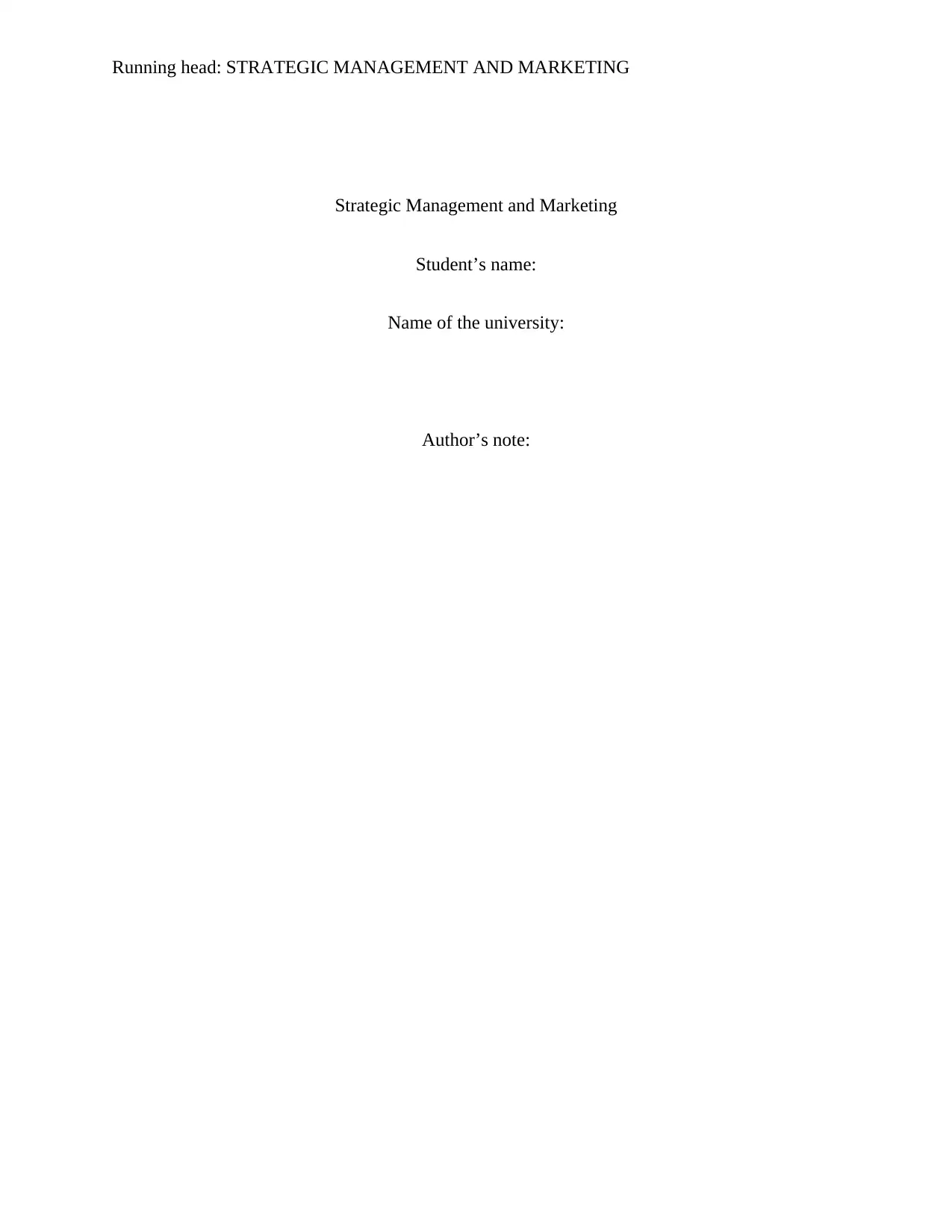
Running head: STRATEGIC MANAGEMENT AND MARKETING
Strategic Management and Marketing
Student’s name:
Name of the university:
Author’s note:
Strategic Management and Marketing
Student’s name:
Name of the university:
Author’s note:
Paraphrase This Document
Need a fresh take? Get an instant paraphrase of this document with our AI Paraphraser
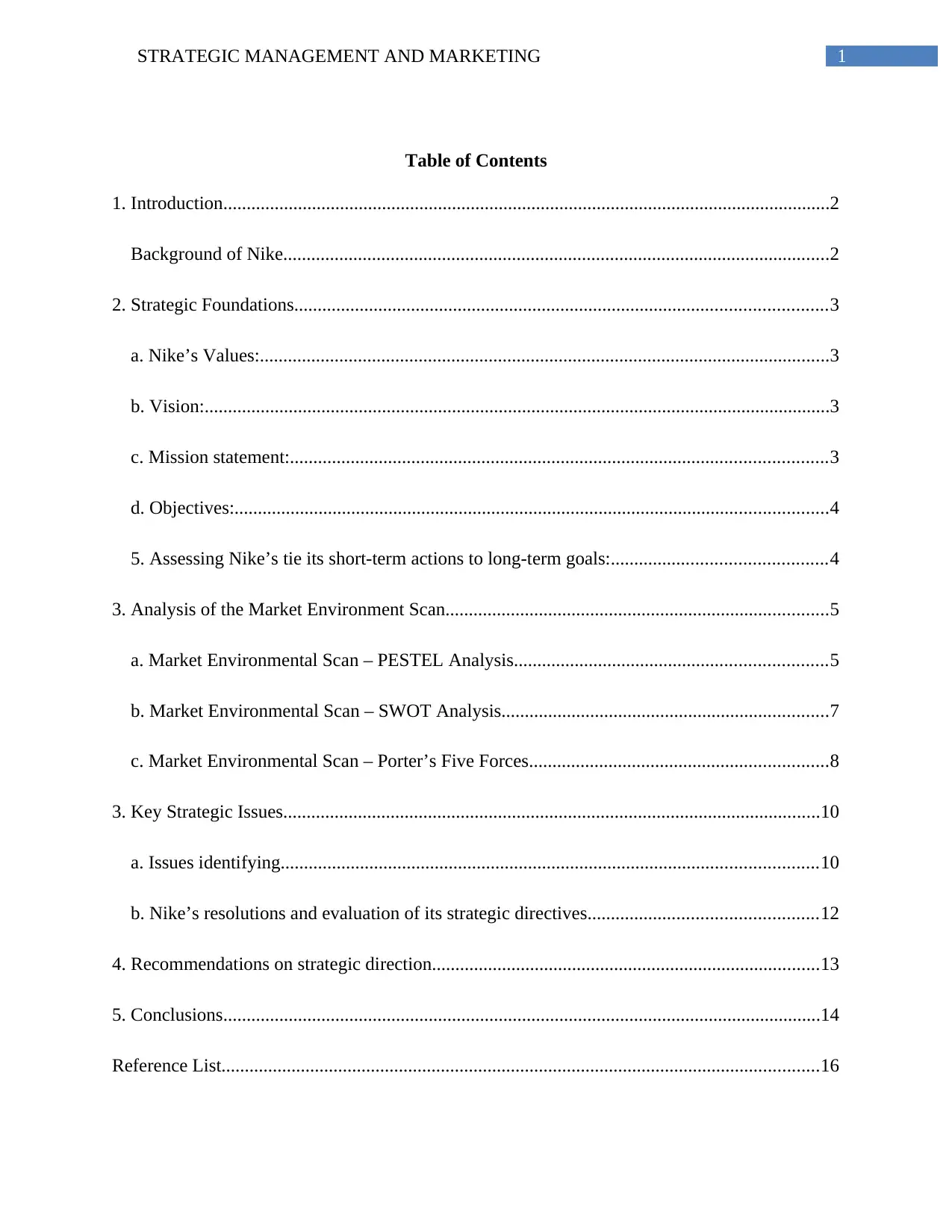
1STRATEGIC MANAGEMENT AND MARKETING
Table of Contents
1. Introduction..................................................................................................................................2
Background of Nike.....................................................................................................................2
2. Strategic Foundations..................................................................................................................3
a. Nike’s Values:..........................................................................................................................3
b. Vision:......................................................................................................................................3
c. Mission statement:...................................................................................................................3
d. Objectives:...............................................................................................................................4
5. Assessing Nike’s tie its short-term actions to long-term goals:..............................................4
3. Analysis of the Market Environment Scan..................................................................................5
a. Market Environmental Scan – PESTEL Analysis...................................................................5
b. Market Environmental Scan – SWOT Analysis......................................................................7
c. Market Environmental Scan – Porter’s Five Forces................................................................8
3. Key Strategic Issues...................................................................................................................10
a. Issues identifying...................................................................................................................10
b. Nike’s resolutions and evaluation of its strategic directives.................................................12
4. Recommendations on strategic direction...................................................................................13
5. Conclusions................................................................................................................................14
Reference List................................................................................................................................16
Table of Contents
1. Introduction..................................................................................................................................2
Background of Nike.....................................................................................................................2
2. Strategic Foundations..................................................................................................................3
a. Nike’s Values:..........................................................................................................................3
b. Vision:......................................................................................................................................3
c. Mission statement:...................................................................................................................3
d. Objectives:...............................................................................................................................4
5. Assessing Nike’s tie its short-term actions to long-term goals:..............................................4
3. Analysis of the Market Environment Scan..................................................................................5
a. Market Environmental Scan – PESTEL Analysis...................................................................5
b. Market Environmental Scan – SWOT Analysis......................................................................7
c. Market Environmental Scan – Porter’s Five Forces................................................................8
3. Key Strategic Issues...................................................................................................................10
a. Issues identifying...................................................................................................................10
b. Nike’s resolutions and evaluation of its strategic directives.................................................12
4. Recommendations on strategic direction...................................................................................13
5. Conclusions................................................................................................................................14
Reference List................................................................................................................................16

2STRATEGIC MANAGEMENT AND MARKETING
⊘ This is a preview!⊘
Do you want full access?
Subscribe today to unlock all pages.

Trusted by 1+ million students worldwide
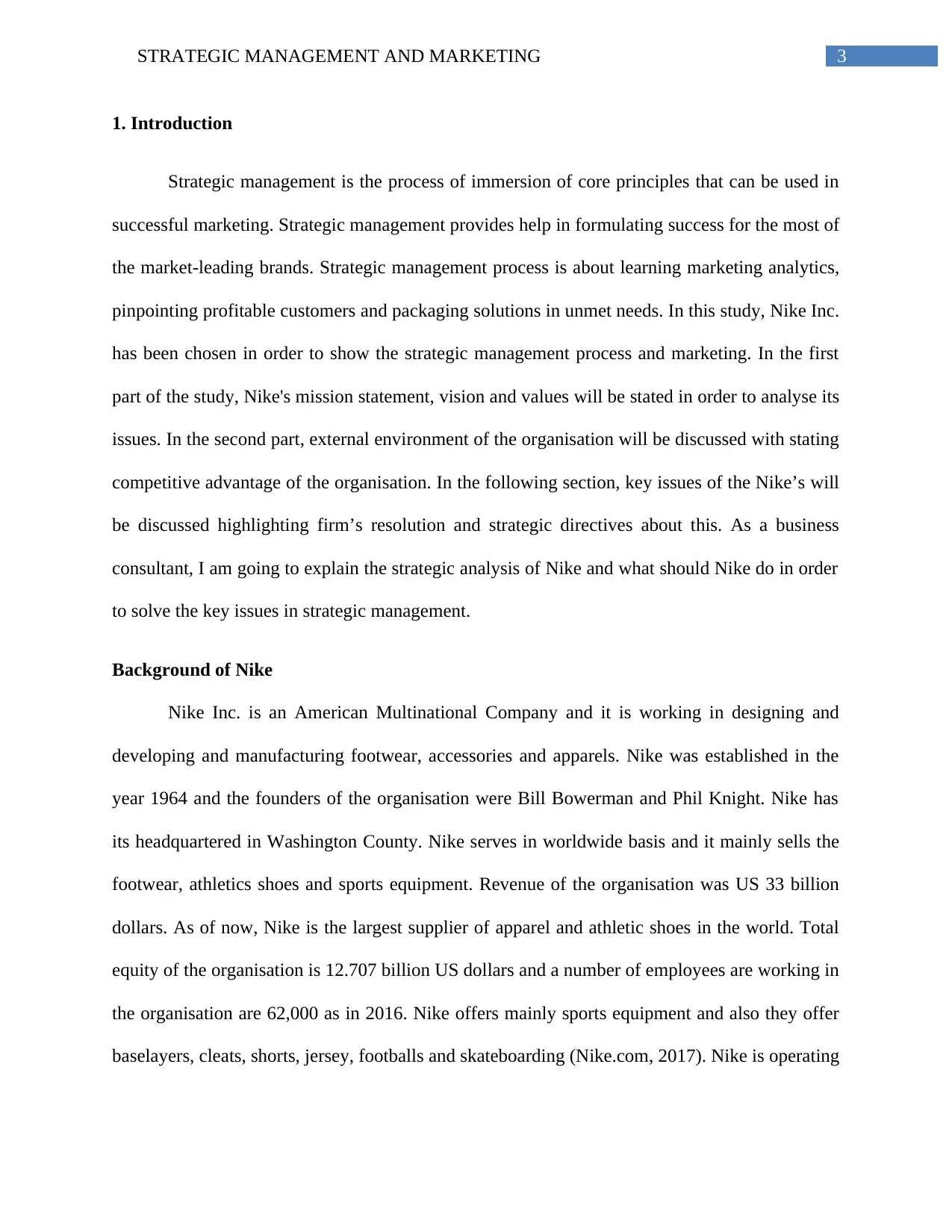
3STRATEGIC MANAGEMENT AND MARKETING
1. Introduction
Strategic management is the process of immersion of core principles that can be used in
successful marketing. Strategic management provides help in formulating success for the most of
the market-leading brands. Strategic management process is about learning marketing analytics,
pinpointing profitable customers and packaging solutions in unmet needs. In this study, Nike Inc.
has been chosen in order to show the strategic management process and marketing. In the first
part of the study, Nike's mission statement, vision and values will be stated in order to analyse its
issues. In the second part, external environment of the organisation will be discussed with stating
competitive advantage of the organisation. In the following section, key issues of the Nike’s will
be discussed highlighting firm’s resolution and strategic directives about this. As a business
consultant, I am going to explain the strategic analysis of Nike and what should Nike do in order
to solve the key issues in strategic management.
Background of Nike
Nike Inc. is an American Multinational Company and it is working in designing and
developing and manufacturing footwear, accessories and apparels. Nike was established in the
year 1964 and the founders of the organisation were Bill Bowerman and Phil Knight. Nike has
its headquartered in Washington County. Nike serves in worldwide basis and it mainly sells the
footwear, athletics shoes and sports equipment. Revenue of the organisation was US 33 billion
dollars. As of now, Nike is the largest supplier of apparel and athletic shoes in the world. Total
equity of the organisation is 12.707 billion US dollars and a number of employees are working in
the organisation are 62,000 as in 2016. Nike offers mainly sports equipment and also they offer
baselayers, cleats, shorts, jersey, footballs and skateboarding (Nike.com, 2017). Nike is operating
1. Introduction
Strategic management is the process of immersion of core principles that can be used in
successful marketing. Strategic management provides help in formulating success for the most of
the market-leading brands. Strategic management process is about learning marketing analytics,
pinpointing profitable customers and packaging solutions in unmet needs. In this study, Nike Inc.
has been chosen in order to show the strategic management process and marketing. In the first
part of the study, Nike's mission statement, vision and values will be stated in order to analyse its
issues. In the second part, external environment of the organisation will be discussed with stating
competitive advantage of the organisation. In the following section, key issues of the Nike’s will
be discussed highlighting firm’s resolution and strategic directives about this. As a business
consultant, I am going to explain the strategic analysis of Nike and what should Nike do in order
to solve the key issues in strategic management.
Background of Nike
Nike Inc. is an American Multinational Company and it is working in designing and
developing and manufacturing footwear, accessories and apparels. Nike was established in the
year 1964 and the founders of the organisation were Bill Bowerman and Phil Knight. Nike has
its headquartered in Washington County. Nike serves in worldwide basis and it mainly sells the
footwear, athletics shoes and sports equipment. Revenue of the organisation was US 33 billion
dollars. As of now, Nike is the largest supplier of apparel and athletic shoes in the world. Total
equity of the organisation is 12.707 billion US dollars and a number of employees are working in
the organisation are 62,000 as in 2016. Nike offers mainly sports equipment and also they offer
baselayers, cleats, shorts, jersey, footballs and skateboarding (Nike.com, 2017). Nike is operating
Paraphrase This Document
Need a fresh take? Get an instant paraphrase of this document with our AI Paraphraser
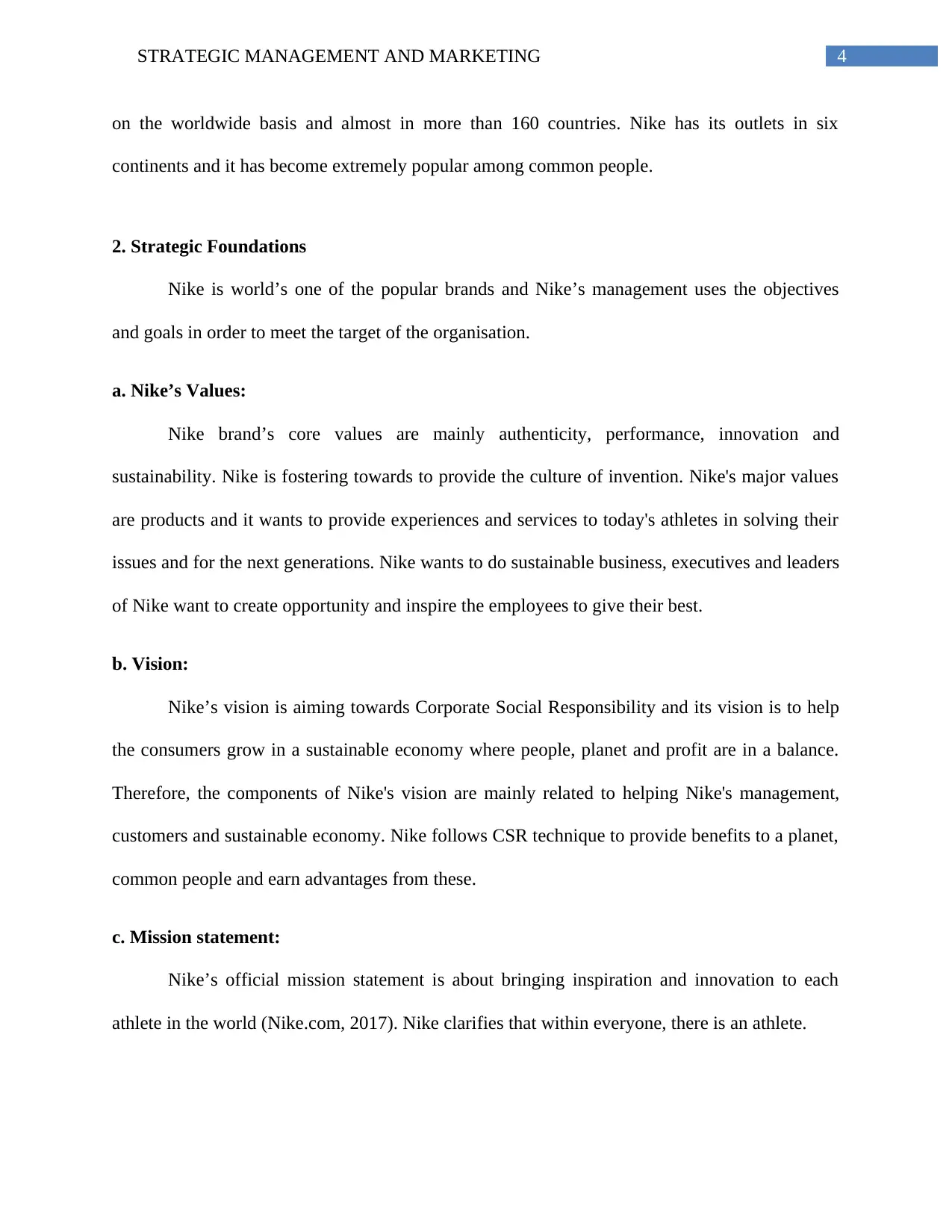
4STRATEGIC MANAGEMENT AND MARKETING
on the worldwide basis and almost in more than 160 countries. Nike has its outlets in six
continents and it has become extremely popular among common people.
2. Strategic Foundations
Nike is world’s one of the popular brands and Nike’s management uses the objectives
and goals in order to meet the target of the organisation.
a. Nike’s Values:
Nike brand’s core values are mainly authenticity, performance, innovation and
sustainability. Nike is fostering towards to provide the culture of invention. Nike's major values
are products and it wants to provide experiences and services to today's athletes in solving their
issues and for the next generations. Nike wants to do sustainable business, executives and leaders
of Nike want to create opportunity and inspire the employees to give their best.
b. Vision:
Nike’s vision is aiming towards Corporate Social Responsibility and its vision is to help
the consumers grow in a sustainable economy where people, planet and profit are in a balance.
Therefore, the components of Nike's vision are mainly related to helping Nike's management,
customers and sustainable economy. Nike follows CSR technique to provide benefits to a planet,
common people and earn advantages from these.
c. Mission statement:
Nike’s official mission statement is about bringing inspiration and innovation to each
athlete in the world (Nike.com, 2017). Nike clarifies that within everyone, there is an athlete.
on the worldwide basis and almost in more than 160 countries. Nike has its outlets in six
continents and it has become extremely popular among common people.
2. Strategic Foundations
Nike is world’s one of the popular brands and Nike’s management uses the objectives
and goals in order to meet the target of the organisation.
a. Nike’s Values:
Nike brand’s core values are mainly authenticity, performance, innovation and
sustainability. Nike is fostering towards to provide the culture of invention. Nike's major values
are products and it wants to provide experiences and services to today's athletes in solving their
issues and for the next generations. Nike wants to do sustainable business, executives and leaders
of Nike want to create opportunity and inspire the employees to give their best.
b. Vision:
Nike’s vision is aiming towards Corporate Social Responsibility and its vision is to help
the consumers grow in a sustainable economy where people, planet and profit are in a balance.
Therefore, the components of Nike's vision are mainly related to helping Nike's management,
customers and sustainable economy. Nike follows CSR technique to provide benefits to a planet,
common people and earn advantages from these.
c. Mission statement:
Nike’s official mission statement is about bringing inspiration and innovation to each
athlete in the world (Nike.com, 2017). Nike clarifies that within everyone, there is an athlete.
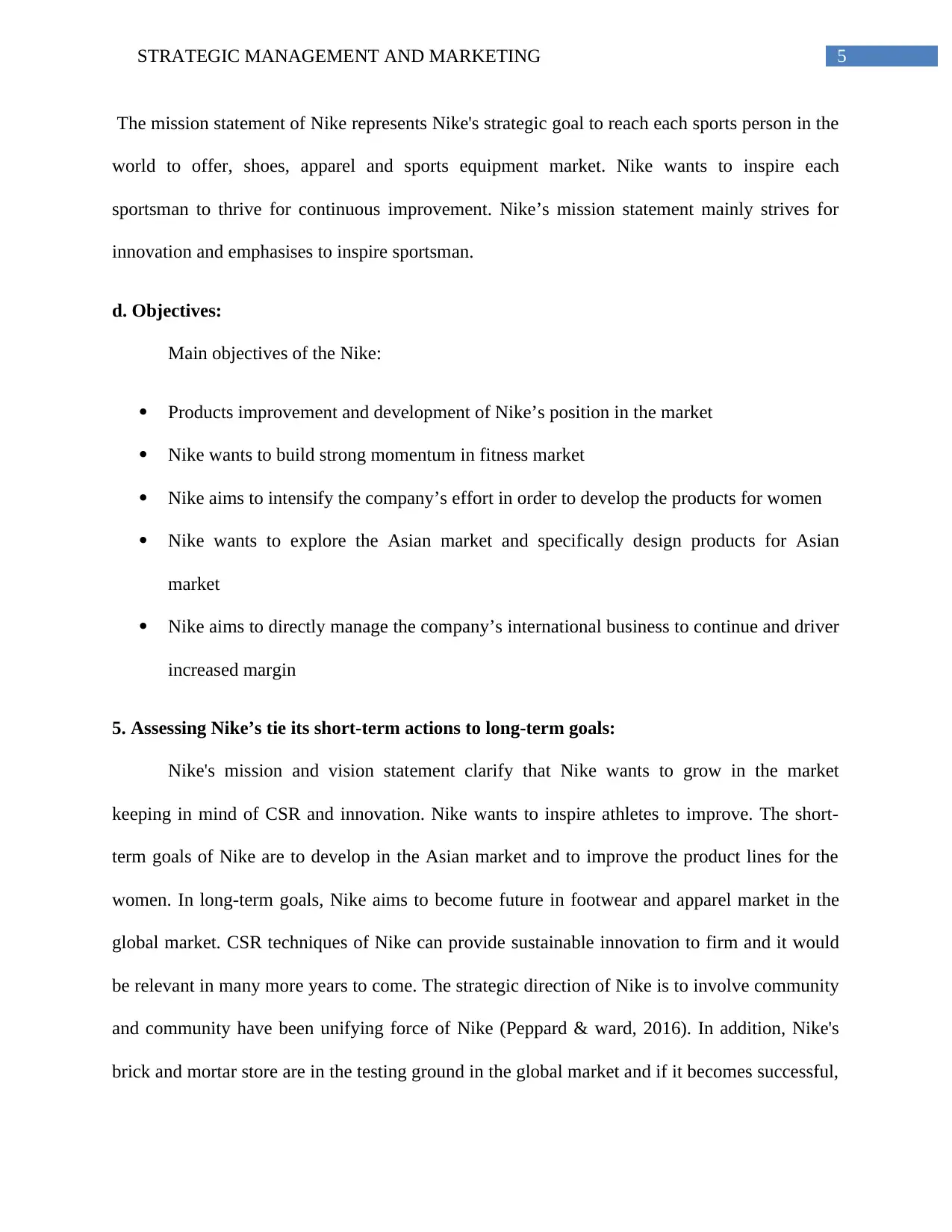
5STRATEGIC MANAGEMENT AND MARKETING
The mission statement of Nike represents Nike's strategic goal to reach each sports person in the
world to offer, shoes, apparel and sports equipment market. Nike wants to inspire each
sportsman to thrive for continuous improvement. Nike’s mission statement mainly strives for
innovation and emphasises to inspire sportsman.
d. Objectives:
Main objectives of the Nike:
Products improvement and development of Nike’s position in the market
Nike wants to build strong momentum in fitness market
Nike aims to intensify the company’s effort in order to develop the products for women
Nike wants to explore the Asian market and specifically design products for Asian
market
Nike aims to directly manage the company’s international business to continue and driver
increased margin
5. Assessing Nike’s tie its short-term actions to long-term goals:
Nike's mission and vision statement clarify that Nike wants to grow in the market
keeping in mind of CSR and innovation. Nike wants to inspire athletes to improve. The short-
term goals of Nike are to develop in the Asian market and to improve the product lines for the
women. In long-term goals, Nike aims to become future in footwear and apparel market in the
global market. CSR techniques of Nike can provide sustainable innovation to firm and it would
be relevant in many more years to come. The strategic direction of Nike is to involve community
and community have been unifying force of Nike (Peppard & ward, 2016). In addition, Nike's
brick and mortar store are in the testing ground in the global market and if it becomes successful,
The mission statement of Nike represents Nike's strategic goal to reach each sports person in the
world to offer, shoes, apparel and sports equipment market. Nike wants to inspire each
sportsman to thrive for continuous improvement. Nike’s mission statement mainly strives for
innovation and emphasises to inspire sportsman.
d. Objectives:
Main objectives of the Nike:
Products improvement and development of Nike’s position in the market
Nike wants to build strong momentum in fitness market
Nike aims to intensify the company’s effort in order to develop the products for women
Nike wants to explore the Asian market and specifically design products for Asian
market
Nike aims to directly manage the company’s international business to continue and driver
increased margin
5. Assessing Nike’s tie its short-term actions to long-term goals:
Nike's mission and vision statement clarify that Nike wants to grow in the market
keeping in mind of CSR and innovation. Nike wants to inspire athletes to improve. The short-
term goals of Nike are to develop in the Asian market and to improve the product lines for the
women. In long-term goals, Nike aims to become future in footwear and apparel market in the
global market. CSR techniques of Nike can provide sustainable innovation to firm and it would
be relevant in many more years to come. The strategic direction of Nike is to involve community
and community have been unifying force of Nike (Peppard & ward, 2016). In addition, Nike's
brick and mortar store are in the testing ground in the global market and if it becomes successful,
⊘ This is a preview!⊘
Do you want full access?
Subscribe today to unlock all pages.

Trusted by 1+ million students worldwide
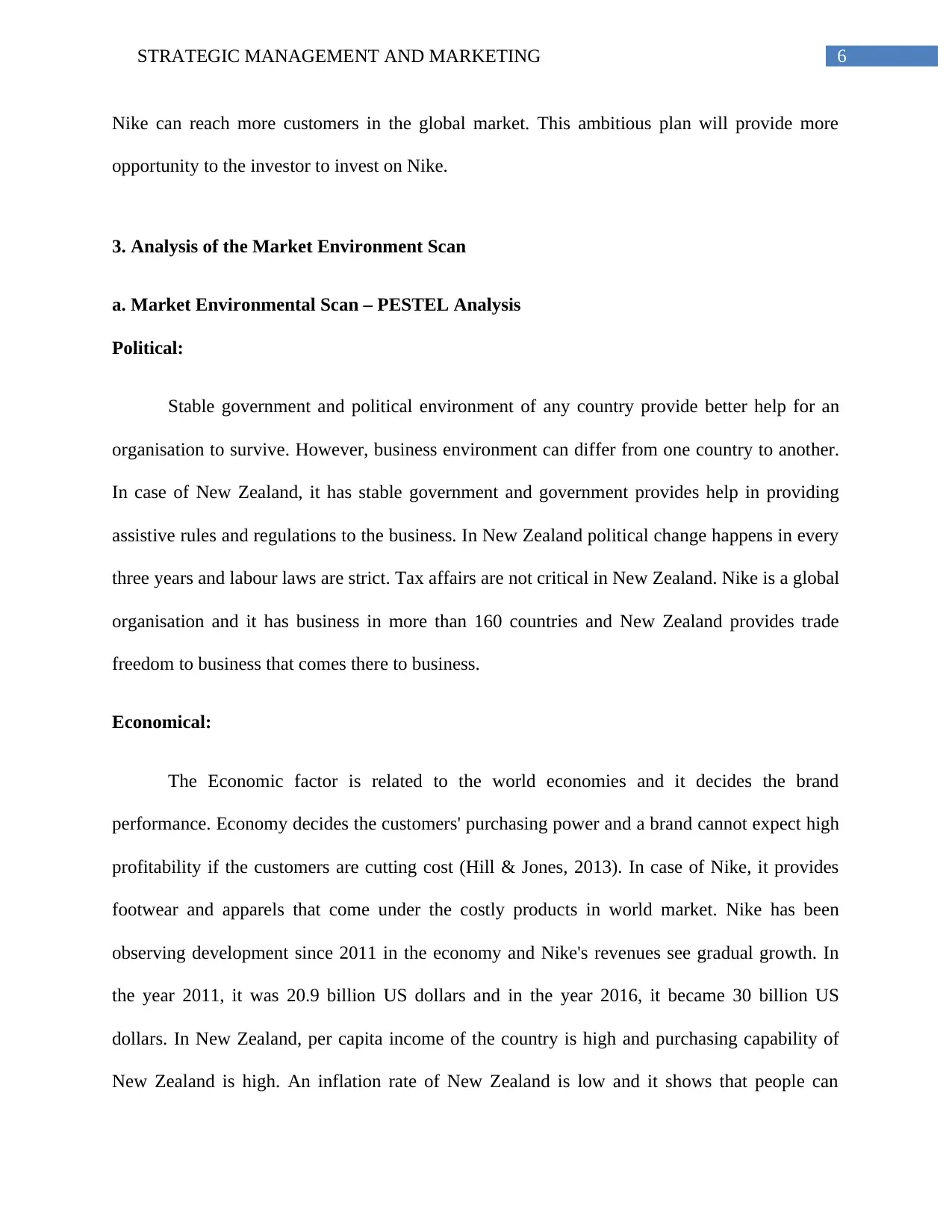
6STRATEGIC MANAGEMENT AND MARKETING
Nike can reach more customers in the global market. This ambitious plan will provide more
opportunity to the investor to invest on Nike.
3. Analysis of the Market Environment Scan
a. Market Environmental Scan – PESTEL Analysis
Political:
Stable government and political environment of any country provide better help for an
organisation to survive. However, business environment can differ from one country to another.
In case of New Zealand, it has stable government and government provides help in providing
assistive rules and regulations to the business. In New Zealand political change happens in every
three years and labour laws are strict. Tax affairs are not critical in New Zealand. Nike is a global
organisation and it has business in more than 160 countries and New Zealand provides trade
freedom to business that comes there to business.
Economical:
The Economic factor is related to the world economies and it decides the brand
performance. Economy decides the customers' purchasing power and a brand cannot expect high
profitability if the customers are cutting cost (Hill & Jones, 2013). In case of Nike, it provides
footwear and apparels that come under the costly products in world market. Nike has been
observing development since 2011 in the economy and Nike's revenues see gradual growth. In
the year 2011, it was 20.9 billion US dollars and in the year 2016, it became 30 billion US
dollars. In New Zealand, per capita income of the country is high and purchasing capability of
New Zealand is high. An inflation rate of New Zealand is low and it shows that people can
Nike can reach more customers in the global market. This ambitious plan will provide more
opportunity to the investor to invest on Nike.
3. Analysis of the Market Environment Scan
a. Market Environmental Scan – PESTEL Analysis
Political:
Stable government and political environment of any country provide better help for an
organisation to survive. However, business environment can differ from one country to another.
In case of New Zealand, it has stable government and government provides help in providing
assistive rules and regulations to the business. In New Zealand political change happens in every
three years and labour laws are strict. Tax affairs are not critical in New Zealand. Nike is a global
organisation and it has business in more than 160 countries and New Zealand provides trade
freedom to business that comes there to business.
Economical:
The Economic factor is related to the world economies and it decides the brand
performance. Economy decides the customers' purchasing power and a brand cannot expect high
profitability if the customers are cutting cost (Hill & Jones, 2013). In case of Nike, it provides
footwear and apparels that come under the costly products in world market. Nike has been
observing development since 2011 in the economy and Nike's revenues see gradual growth. In
the year 2011, it was 20.9 billion US dollars and in the year 2016, it became 30 billion US
dollars. In New Zealand, per capita income of the country is high and purchasing capability of
New Zealand is high. An inflation rate of New Zealand is low and it shows that people can
Paraphrase This Document
Need a fresh take? Get an instant paraphrase of this document with our AI Paraphraser
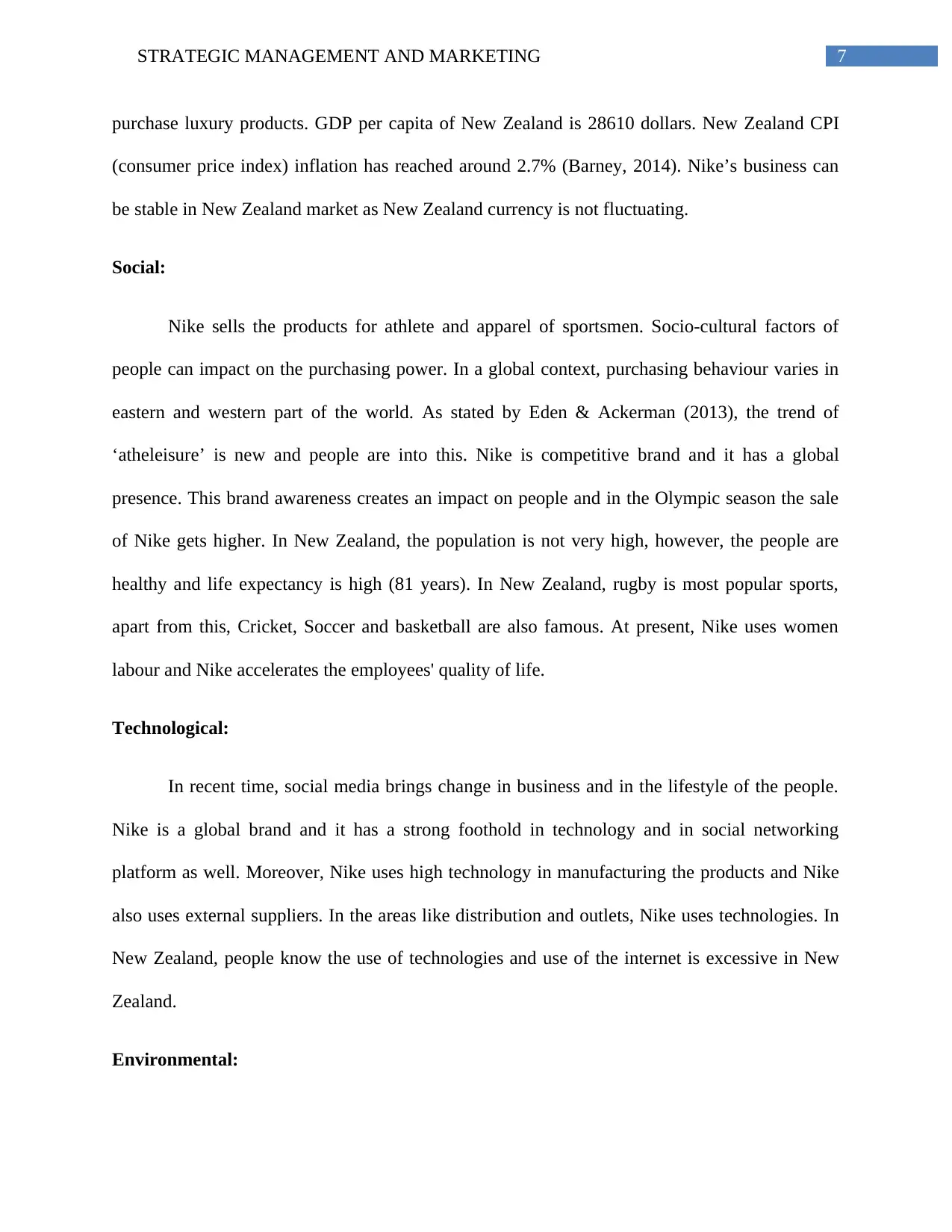
7STRATEGIC MANAGEMENT AND MARKETING
purchase luxury products. GDP per capita of New Zealand is 28610 dollars. New Zealand CPI
(consumer price index) inflation has reached around 2.7% (Barney, 2014). Nike’s business can
be stable in New Zealand market as New Zealand currency is not fluctuating.
Social:
Nike sells the products for athlete and apparel of sportsmen. Socio-cultural factors of
people can impact on the purchasing power. In a global context, purchasing behaviour varies in
eastern and western part of the world. As stated by Eden & Ackerman (2013), the trend of
‘atheleisure’ is new and people are into this. Nike is competitive brand and it has a global
presence. This brand awareness creates an impact on people and in the Olympic season the sale
of Nike gets higher. In New Zealand, the population is not very high, however, the people are
healthy and life expectancy is high (81 years). In New Zealand, rugby is most popular sports,
apart from this, Cricket, Soccer and basketball are also famous. At present, Nike uses women
labour and Nike accelerates the employees' quality of life.
Technological:
In recent time, social media brings change in business and in the lifestyle of the people.
Nike is a global brand and it has a strong foothold in technology and in social networking
platform as well. Moreover, Nike uses high technology in manufacturing the products and Nike
also uses external suppliers. In the areas like distribution and outlets, Nike uses technologies. In
New Zealand, people know the use of technologies and use of the internet is excessive in New
Zealand.
Environmental:
purchase luxury products. GDP per capita of New Zealand is 28610 dollars. New Zealand CPI
(consumer price index) inflation has reached around 2.7% (Barney, 2014). Nike’s business can
be stable in New Zealand market as New Zealand currency is not fluctuating.
Social:
Nike sells the products for athlete and apparel of sportsmen. Socio-cultural factors of
people can impact on the purchasing power. In a global context, purchasing behaviour varies in
eastern and western part of the world. As stated by Eden & Ackerman (2013), the trend of
‘atheleisure’ is new and people are into this. Nike is competitive brand and it has a global
presence. This brand awareness creates an impact on people and in the Olympic season the sale
of Nike gets higher. In New Zealand, the population is not very high, however, the people are
healthy and life expectancy is high (81 years). In New Zealand, rugby is most popular sports,
apart from this, Cricket, Soccer and basketball are also famous. At present, Nike uses women
labour and Nike accelerates the employees' quality of life.
Technological:
In recent time, social media brings change in business and in the lifestyle of the people.
Nike is a global brand and it has a strong foothold in technology and in social networking
platform as well. Moreover, Nike uses high technology in manufacturing the products and Nike
also uses external suppliers. In the areas like distribution and outlets, Nike uses technologies. In
New Zealand, people know the use of technologies and use of the internet is excessive in New
Zealand.
Environmental:
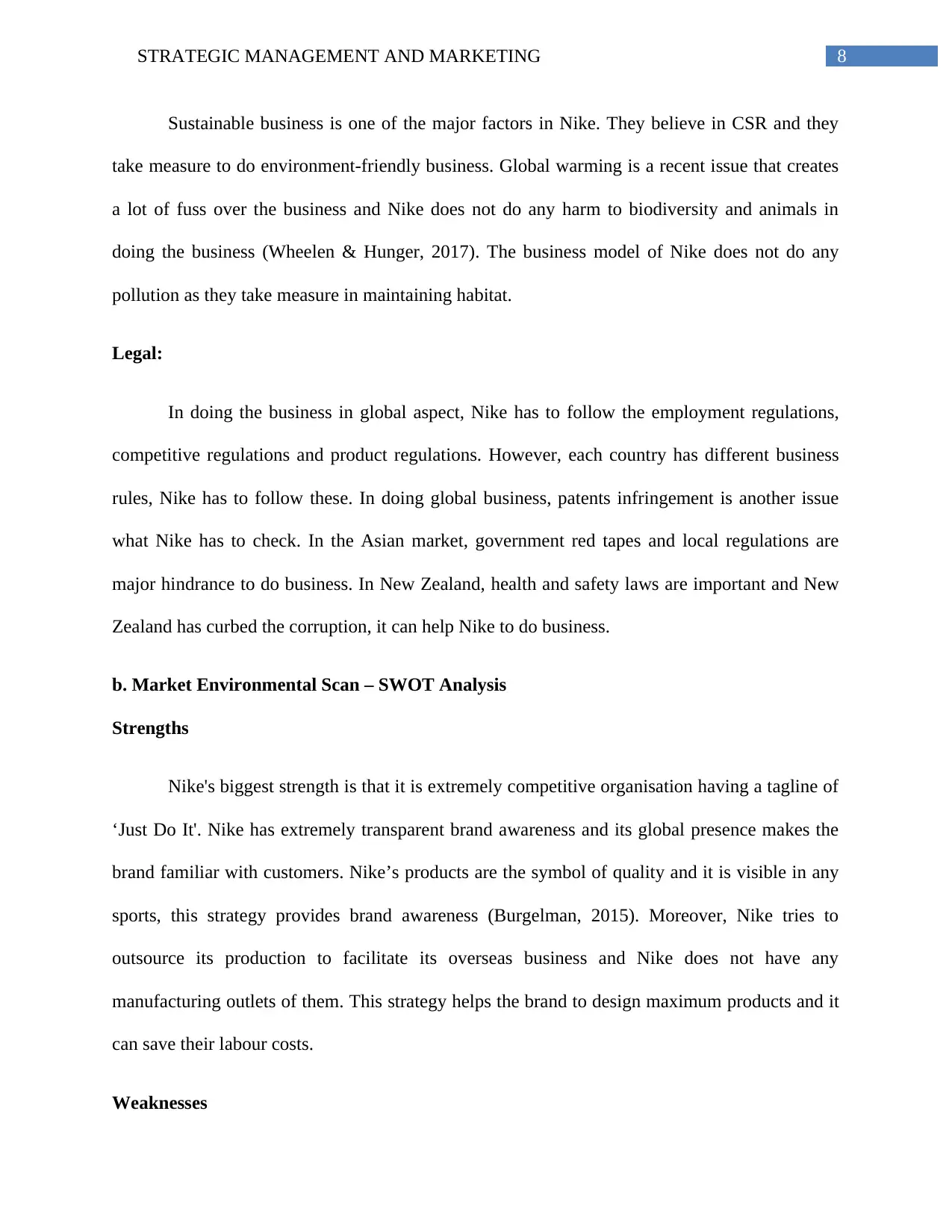
8STRATEGIC MANAGEMENT AND MARKETING
Sustainable business is one of the major factors in Nike. They believe in CSR and they
take measure to do environment-friendly business. Global warming is a recent issue that creates
a lot of fuss over the business and Nike does not do any harm to biodiversity and animals in
doing the business (Wheelen & Hunger, 2017). The business model of Nike does not do any
pollution as they take measure in maintaining habitat.
Legal:
In doing the business in global aspect, Nike has to follow the employment regulations,
competitive regulations and product regulations. However, each country has different business
rules, Nike has to follow these. In doing global business, patents infringement is another issue
what Nike has to check. In the Asian market, government red tapes and local regulations are
major hindrance to do business. In New Zealand, health and safety laws are important and New
Zealand has curbed the corruption, it can help Nike to do business.
b. Market Environmental Scan – SWOT Analysis
Strengths
Nike's biggest strength is that it is extremely competitive organisation having a tagline of
‘Just Do It'. Nike has extremely transparent brand awareness and its global presence makes the
brand familiar with customers. Nike’s products are the symbol of quality and it is visible in any
sports, this strategy provides brand awareness (Burgelman, 2015). Moreover, Nike tries to
outsource its production to facilitate its overseas business and Nike does not have any
manufacturing outlets of them. This strategy helps the brand to design maximum products and it
can save their labour costs.
Weaknesses
Sustainable business is one of the major factors in Nike. They believe in CSR and they
take measure to do environment-friendly business. Global warming is a recent issue that creates
a lot of fuss over the business and Nike does not do any harm to biodiversity and animals in
doing the business (Wheelen & Hunger, 2017). The business model of Nike does not do any
pollution as they take measure in maintaining habitat.
Legal:
In doing the business in global aspect, Nike has to follow the employment regulations,
competitive regulations and product regulations. However, each country has different business
rules, Nike has to follow these. In doing global business, patents infringement is another issue
what Nike has to check. In the Asian market, government red tapes and local regulations are
major hindrance to do business. In New Zealand, health and safety laws are important and New
Zealand has curbed the corruption, it can help Nike to do business.
b. Market Environmental Scan – SWOT Analysis
Strengths
Nike's biggest strength is that it is extremely competitive organisation having a tagline of
‘Just Do It'. Nike has extremely transparent brand awareness and its global presence makes the
brand familiar with customers. Nike’s products are the symbol of quality and it is visible in any
sports, this strategy provides brand awareness (Burgelman, 2015). Moreover, Nike tries to
outsource its production to facilitate its overseas business and Nike does not have any
manufacturing outlets of them. This strategy helps the brand to design maximum products and it
can save their labour costs.
Weaknesses
⊘ This is a preview!⊘
Do you want full access?
Subscribe today to unlock all pages.

Trusted by 1+ million students worldwide
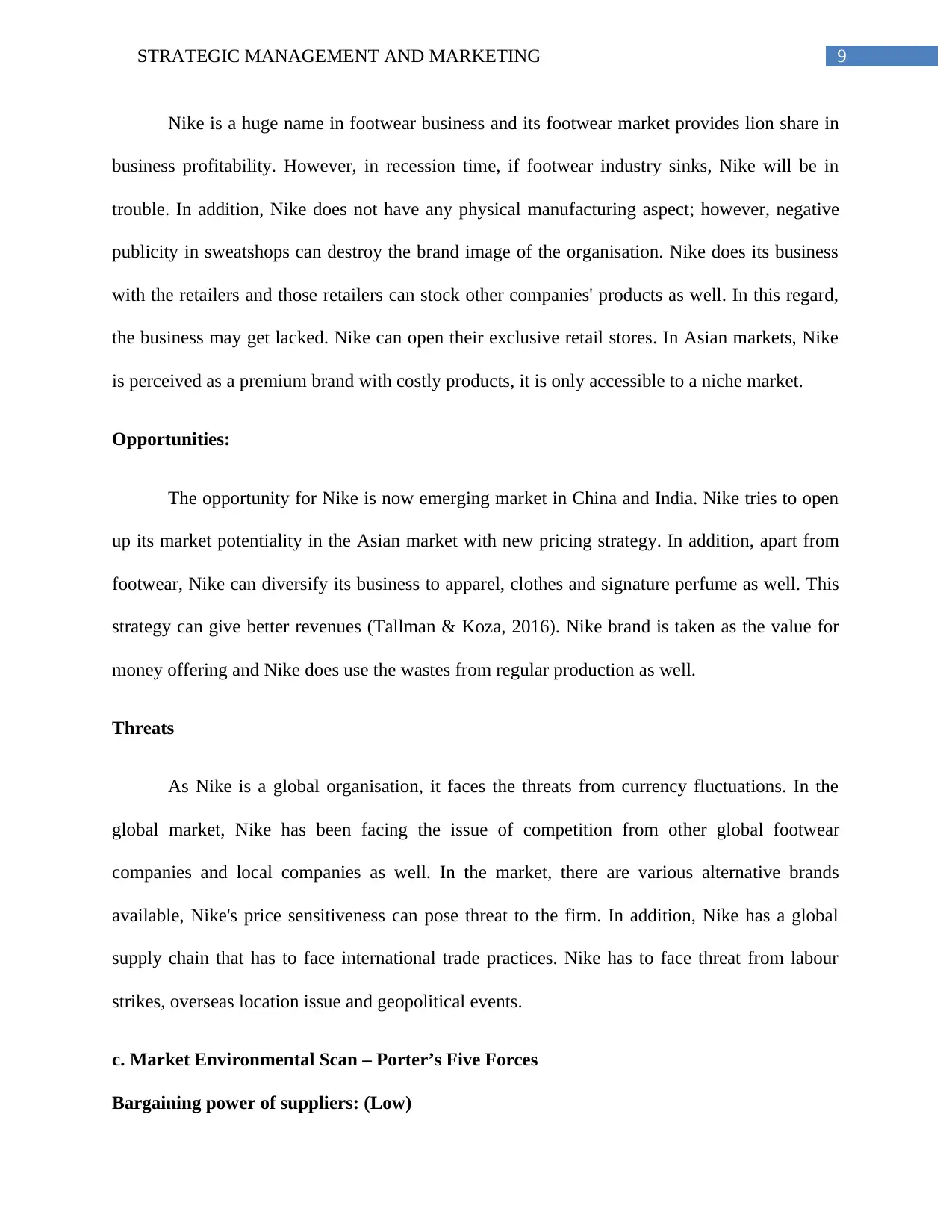
9STRATEGIC MANAGEMENT AND MARKETING
Nike is a huge name in footwear business and its footwear market provides lion share in
business profitability. However, in recession time, if footwear industry sinks, Nike will be in
trouble. In addition, Nike does not have any physical manufacturing aspect; however, negative
publicity in sweatshops can destroy the brand image of the organisation. Nike does its business
with the retailers and those retailers can stock other companies' products as well. In this regard,
the business may get lacked. Nike can open their exclusive retail stores. In Asian markets, Nike
is perceived as a premium brand with costly products, it is only accessible to a niche market.
Opportunities:
The opportunity for Nike is now emerging market in China and India. Nike tries to open
up its market potentiality in the Asian market with new pricing strategy. In addition, apart from
footwear, Nike can diversify its business to apparel, clothes and signature perfume as well. This
strategy can give better revenues (Tallman & Koza, 2016). Nike brand is taken as the value for
money offering and Nike does use the wastes from regular production as well.
Threats
As Nike is a global organisation, it faces the threats from currency fluctuations. In the
global market, Nike has been facing the issue of competition from other global footwear
companies and local companies as well. In the market, there are various alternative brands
available, Nike's price sensitiveness can pose threat to the firm. In addition, Nike has a global
supply chain that has to face international trade practices. Nike has to face threat from labour
strikes, overseas location issue and geopolitical events.
c. Market Environmental Scan – Porter’s Five Forces
Bargaining power of suppliers: (Low)
Nike is a huge name in footwear business and its footwear market provides lion share in
business profitability. However, in recession time, if footwear industry sinks, Nike will be in
trouble. In addition, Nike does not have any physical manufacturing aspect; however, negative
publicity in sweatshops can destroy the brand image of the organisation. Nike does its business
with the retailers and those retailers can stock other companies' products as well. In this regard,
the business may get lacked. Nike can open their exclusive retail stores. In Asian markets, Nike
is perceived as a premium brand with costly products, it is only accessible to a niche market.
Opportunities:
The opportunity for Nike is now emerging market in China and India. Nike tries to open
up its market potentiality in the Asian market with new pricing strategy. In addition, apart from
footwear, Nike can diversify its business to apparel, clothes and signature perfume as well. This
strategy can give better revenues (Tallman & Koza, 2016). Nike brand is taken as the value for
money offering and Nike does use the wastes from regular production as well.
Threats
As Nike is a global organisation, it faces the threats from currency fluctuations. In the
global market, Nike has been facing the issue of competition from other global footwear
companies and local companies as well. In the market, there are various alternative brands
available, Nike's price sensitiveness can pose threat to the firm. In addition, Nike has a global
supply chain that has to face international trade practices. Nike has to face threat from labour
strikes, overseas location issue and geopolitical events.
c. Market Environmental Scan – Porter’s Five Forces
Bargaining power of suppliers: (Low)
Paraphrase This Document
Need a fresh take? Get an instant paraphrase of this document with our AI Paraphraser
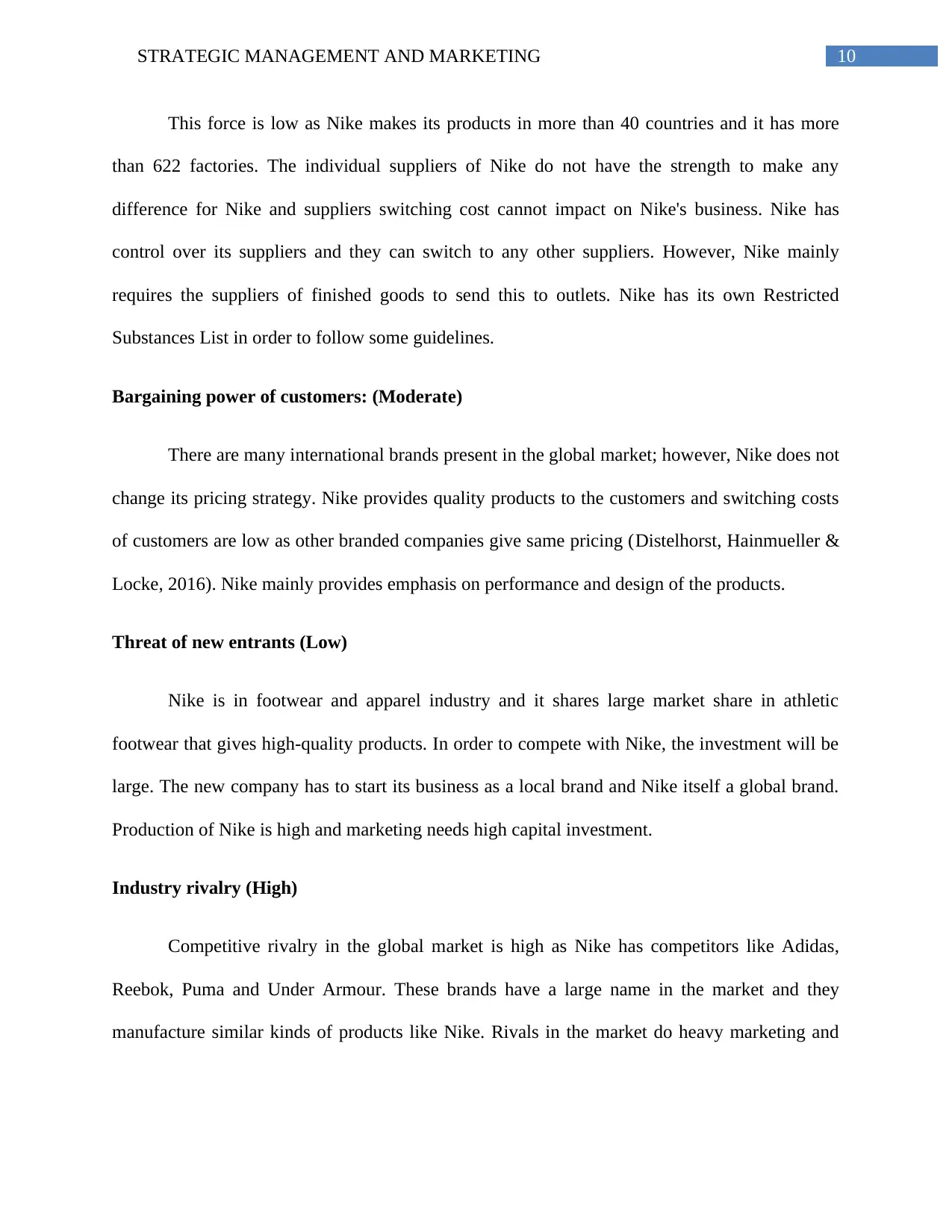
10STRATEGIC MANAGEMENT AND MARKETING
This force is low as Nike makes its products in more than 40 countries and it has more
than 622 factories. The individual suppliers of Nike do not have the strength to make any
difference for Nike and suppliers switching cost cannot impact on Nike's business. Nike has
control over its suppliers and they can switch to any other suppliers. However, Nike mainly
requires the suppliers of finished goods to send this to outlets. Nike has its own Restricted
Substances List in order to follow some guidelines.
Bargaining power of customers: (Moderate)
There are many international brands present in the global market; however, Nike does not
change its pricing strategy. Nike provides quality products to the customers and switching costs
of customers are low as other branded companies give same pricing (Distelhorst, Hainmueller &
Locke, 2016). Nike mainly provides emphasis on performance and design of the products.
Threat of new entrants (Low)
Nike is in footwear and apparel industry and it shares large market share in athletic
footwear that gives high-quality products. In order to compete with Nike, the investment will be
large. The new company has to start its business as a local brand and Nike itself a global brand.
Production of Nike is high and marketing needs high capital investment.
Industry rivalry (High)
Competitive rivalry in the global market is high as Nike has competitors like Adidas,
Reebok, Puma and Under Armour. These brands have a large name in the market and they
manufacture similar kinds of products like Nike. Rivals in the market do heavy marketing and
This force is low as Nike makes its products in more than 40 countries and it has more
than 622 factories. The individual suppliers of Nike do not have the strength to make any
difference for Nike and suppliers switching cost cannot impact on Nike's business. Nike has
control over its suppliers and they can switch to any other suppliers. However, Nike mainly
requires the suppliers of finished goods to send this to outlets. Nike has its own Restricted
Substances List in order to follow some guidelines.
Bargaining power of customers: (Moderate)
There are many international brands present in the global market; however, Nike does not
change its pricing strategy. Nike provides quality products to the customers and switching costs
of customers are low as other branded companies give same pricing (Distelhorst, Hainmueller &
Locke, 2016). Nike mainly provides emphasis on performance and design of the products.
Threat of new entrants (Low)
Nike is in footwear and apparel industry and it shares large market share in athletic
footwear that gives high-quality products. In order to compete with Nike, the investment will be
large. The new company has to start its business as a local brand and Nike itself a global brand.
Production of Nike is high and marketing needs high capital investment.
Industry rivalry (High)
Competitive rivalry in the global market is high as Nike has competitors like Adidas,
Reebok, Puma and Under Armour. These brands have a large name in the market and they
manufacture similar kinds of products like Nike. Rivals in the market do heavy marketing and
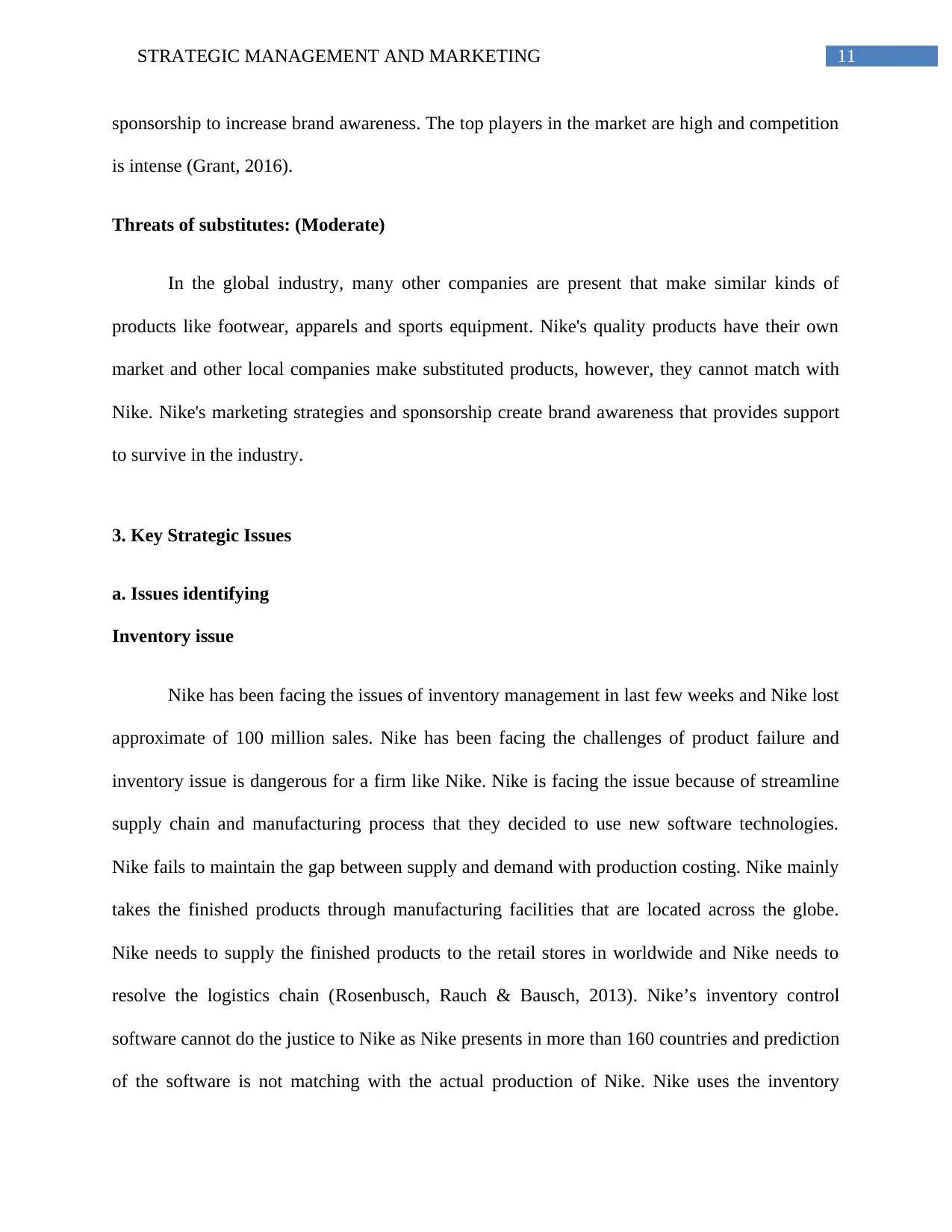
11STRATEGIC MANAGEMENT AND MARKETING
sponsorship to increase brand awareness. The top players in the market are high and competition
is intense (Grant, 2016).
Threats of substitutes: (Moderate)
In the global industry, many other companies are present that make similar kinds of
products like footwear, apparels and sports equipment. Nike's quality products have their own
market and other local companies make substituted products, however, they cannot match with
Nike. Nike's marketing strategies and sponsorship create brand awareness that provides support
to survive in the industry.
3. Key Strategic Issues
a. Issues identifying
Inventory issue
Nike has been facing the issues of inventory management in last few weeks and Nike lost
approximate of 100 million sales. Nike has been facing the challenges of product failure and
inventory issue is dangerous for a firm like Nike. Nike is facing the issue because of streamline
supply chain and manufacturing process that they decided to use new software technologies.
Nike fails to maintain the gap between supply and demand with production costing. Nike mainly
takes the finished products through manufacturing facilities that are located across the globe.
Nike needs to supply the finished products to the retail stores in worldwide and Nike needs to
resolve the logistics chain (Rosenbusch, Rauch & Bausch, 2013). Nike’s inventory control
software cannot do the justice to Nike as Nike presents in more than 160 countries and prediction
of the software is not matching with the actual production of Nike. Nike uses the inventory
sponsorship to increase brand awareness. The top players in the market are high and competition
is intense (Grant, 2016).
Threats of substitutes: (Moderate)
In the global industry, many other companies are present that make similar kinds of
products like footwear, apparels and sports equipment. Nike's quality products have their own
market and other local companies make substituted products, however, they cannot match with
Nike. Nike's marketing strategies and sponsorship create brand awareness that provides support
to survive in the industry.
3. Key Strategic Issues
a. Issues identifying
Inventory issue
Nike has been facing the issues of inventory management in last few weeks and Nike lost
approximate of 100 million sales. Nike has been facing the challenges of product failure and
inventory issue is dangerous for a firm like Nike. Nike is facing the issue because of streamline
supply chain and manufacturing process that they decided to use new software technologies.
Nike fails to maintain the gap between supply and demand with production costing. Nike mainly
takes the finished products through manufacturing facilities that are located across the globe.
Nike needs to supply the finished products to the retail stores in worldwide and Nike needs to
resolve the logistics chain (Rosenbusch, Rauch & Bausch, 2013). Nike’s inventory control
software cannot do the justice to Nike as Nike presents in more than 160 countries and prediction
of the software is not matching with the actual production of Nike. Nike uses the inventory
⊘ This is a preview!⊘
Do you want full access?
Subscribe today to unlock all pages.

Trusted by 1+ million students worldwide
1 out of 20
Related Documents
Your All-in-One AI-Powered Toolkit for Academic Success.
+13062052269
info@desklib.com
Available 24*7 on WhatsApp / Email
![[object Object]](/_next/static/media/star-bottom.7253800d.svg)
Unlock your academic potential
Copyright © 2020–2025 A2Z Services. All Rights Reserved. Developed and managed by ZUCOL.





